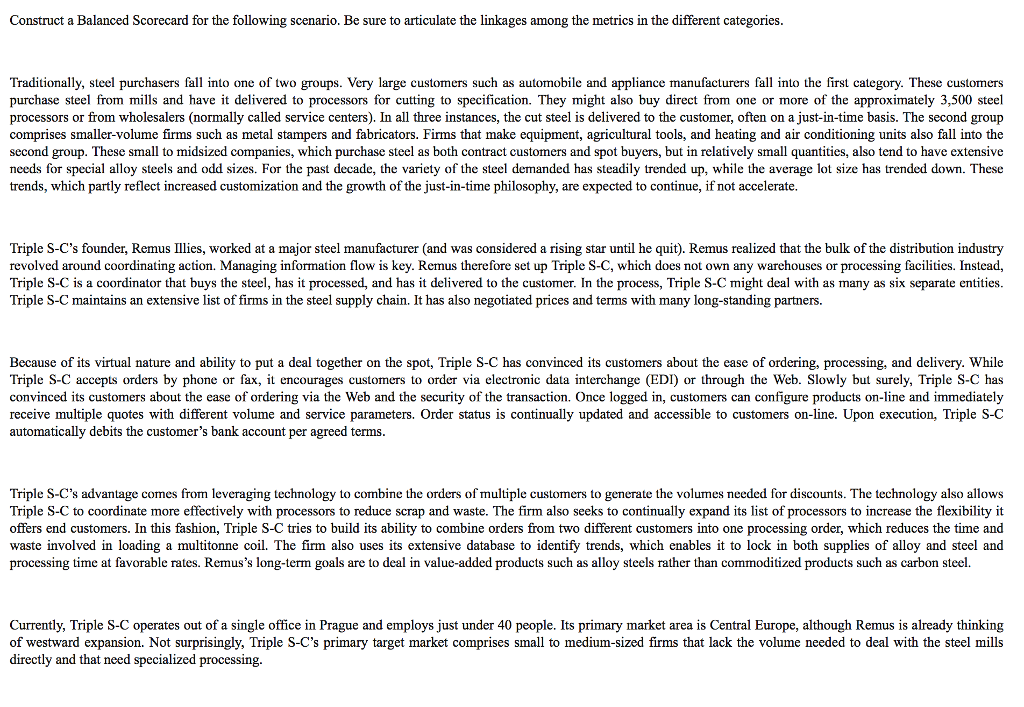
Construct a Balanced Scorecard for the following scenario. Be sure to articulate the linkages among the metrics in the different categories Traditionally, steel purchasers fall into one of two groups. Very large customers such as automobile and appliance manufacturers fall into the first category. These customers purchase steel from mills and have it delivered to processors for cutting to specification. They might also buy direct from one or more of the approximately 3,500 steel processors or from wholesalers (normally called service centers). In all three instances, the cut steel is delivered to the customer, often on a just-in-time basis. The second group comprises smaller-volume firms such as metal stampers and fabricators. Firms that make equipment, agricultural tools, and heating and air conditioning units also fall into the second group. These small to midsized companies, which purchase steel as both contract customers and spot buyers, but in relatively small quantities, also tend to have extensive needs for special alloy steels and odd sizes. For the past decade, the variety of the steel demanded has steadily trended up, while the average lot size has trended down. These trends, which partly reflect increased customization and the growth of the just-in-time philosophy, are expected to continue, if not accelerate. Triple S-C's founder, Remus Illies, worked at a major steel manufacturer (and was considered a rising star until he quit). Remus realized that the bulk of the distribution industry revolved around coordinating action. Managing information flow is key. Remus therefore set up Triple S-C, which does not own any warehouses or processing facilities. Instead, Triple S-C is a coordinator that buys the steel, has it processed, and has it delivered to the customer. In the process, Triple S-C might deal with as many as six separate entities Triple S-C maintains an extensive list of firms in the steel supply chain. It has also negotiated prices and terms with many long-standing partners. Because of its virtual nature and ability to put a deal together on the spot, Triple S-C has convinced its customers about the ease of ordering, processing, and delivery. While Triple S-C accepts orders by phone or fax, it encourages customers to order via electronic data interchange (EDI) or through the Web. Slowly but surely, Triple S-C ha!s convinced its customers about the ease of ordering via the Web and the security of the transaction. Once logged in, customers can configure products on-line and immediately receive multiple quotes with different volume and service parameters. Order status is continually updated and accessible to customers on-line. Upon execution, Triple S-C automatically debits the customer's bank account per agreed terms Triple S-C's advantage comes from leveraging technology to combine the orders of multiple customers to generate the volumes needed for discounts. The technology also allows Triple S-C to coordinate more effectively with processors to reduce scrap and waste. The firm also seeks to continually expand its list of processors to increase the flexibility it offers end customers. In this fashion, Triple S-C tries to build its ability to combine orders from two different customers into one processing order, which reduces the time and waste involved in loading a multitonne coil. The firm also uses its extensive database to identify trends, which enables it to lock in both supplies of alloy and steel and processing time at favorable rates. Remus's long-term goals are to deal in value-added products such as alloy steels rather than commoditized products such as carbon steel. Currently, Triple S-C operates out of a single office in Prague and employs just under 40 people. Its primary market area is Central Europe, although Remus is already thinking of westward expansion. Not surprisingly, Triple S-C's primary target market comprises small to medium-sized firms that lack the volume needed to deal with the steel mills directly and that need specialized processing. Construct a Balanced Scorecard for the following scenario. Be sure to articulate the linkages among the metrics in the different categories Traditionally, steel purchasers fall into one of two groups. Very large customers such as automobile and appliance manufacturers fall into the first category. These customers purchase steel from mills and have it delivered to processors for cutting to specification. They might also buy direct from one or more of the approximately 3,500 steel processors or from wholesalers (normally called service centers). In all three instances, the cut steel is delivered to the customer, often on a just-in-time basis. The second group comprises smaller-volume firms such as metal stampers and fabricators. Firms that make equipment, agricultural tools, and heating and air conditioning units also fall into the second group. These small to midsized companies, which purchase steel as both contract customers and spot buyers, but in relatively small quantities, also tend to have extensive needs for special alloy steels and odd sizes. For the past decade, the variety of the steel demanded has steadily trended up, while the average lot size has trended down. These trends, which partly reflect increased customization and the growth of the just-in-time philosophy, are expected to continue, if not accelerate. Triple S-C's founder, Remus Illies, worked at a major steel manufacturer (and was considered a rising star until he quit). Remus realized that the bulk of the distribution industry revolved around coordinating action. Managing information flow is key. Remus therefore set up Triple S-C, which does not own any warehouses or processing facilities. Instead, Triple S-C is a coordinator that buys the steel, has it processed, and has it delivered to the customer. In the process, Triple S-C might deal with as many as six separate entities Triple S-C maintains an extensive list of firms in the steel supply chain. It has also negotiated prices and terms with many long-standing partners. Because of its virtual nature and ability to put a deal together on the spot, Triple S-C has convinced its customers about the ease of ordering, processing, and delivery. While Triple S-C accepts orders by phone or fax, it encourages customers to order via electronic data interchange (EDI) or through the Web. Slowly but surely, Triple S-C ha!s convinced its customers about the ease of ordering via the Web and the security of the transaction. Once logged in, customers can configure products on-line and immediately receive multiple quotes with different volume and service parameters. Order status is continually updated and accessible to customers on-line. Upon execution, Triple S-C automatically debits the customer's bank account per agreed terms Triple S-C's advantage comes from leveraging technology to combine the orders of multiple customers to generate the volumes needed for discounts. The technology also allows Triple S-C to coordinate more effectively with processors to reduce scrap and waste. The firm also seeks to continually expand its list of processors to increase the flexibility it offers end customers. In this fashion, Triple S-C tries to build its ability to combine orders from two different customers into one processing order, which reduces the time and waste involved in loading a multitonne coil. The firm also uses its extensive database to identify trends, which enables it to lock in both supplies of alloy and steel and processing time at favorable rates. Remus's long-term goals are to deal in value-added products such as alloy steels rather than commoditized products such as carbon steel. Currently, Triple S-C operates out of a single office in Prague and employs just under 40 people. Its primary market area is Central Europe, although Remus is already thinking of westward expansion. Not surprisingly, Triple S-C's primary target market comprises small to medium-sized firms that lack the volume needed to deal with the steel mills directly and that need specialized processing







